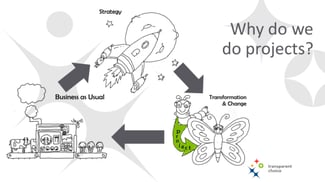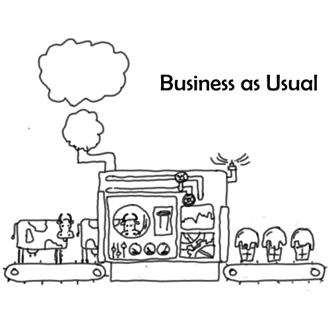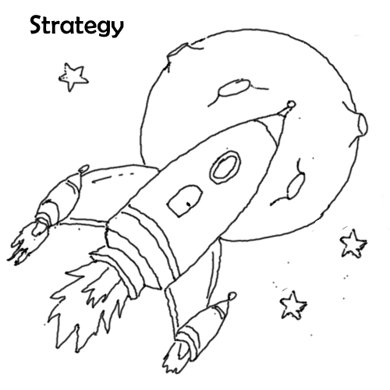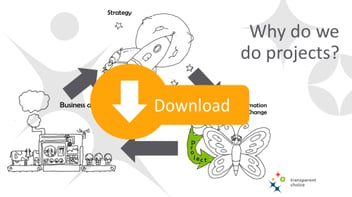What’s the point of doing projects?
Updated:
Published:
 Ever had that feeling? You’re sitting in a management training course and you can’t fight the impression that what they are trying to teach you is what, in the UK, we call “The Bleeding Obvious!”
Ever had that feeling? You’re sitting in a management training course and you can’t fight the impression that what they are trying to teach you is what, in the UK, we call “The Bleeding Obvious!”
But do you know what? It might be obvious, but being reminded of the obvious every now and again is good for you.
Which itself is kind of obvious.
So, my goal today is to state the obvious – but for many, it’s not obvious.
Yes, I want to talk about WHY we bother with all the hassle and the pain of doing projects. It’s easy to get so caught up in the deliverables, in the stakeholder management, and the Gannt charts that we forget what the point of doing projects is…

Your organization is chugging away converting inputs into outputs.
It could be turning milk into ice-cream, or it could be setting up tarpaulin shelters for those in need… but this day-to-day activity just kind of happens.
It’s BUSINESS AS USUAL or BAU.
But then something happens. A few people in suits arrive and drag your leaders off-site for a few days, and what they do is dangerous to BAU.
They think.
They think about the performance metrics of BAU. They think about the market, about competitive advantage, and about the economy. Inevitably, they start to dream of a better future…
…and they give their dream a name; they call it STRATEGY. And the name is good.

But to execute their strategy, things have to change. The BAU of today has to be disturbed and converted into the BAU as envisaged in THE STRATEGY.
Now, making this change happen involves people from all around the organization. You need end-users, procurement people, developers and engineers, but these people all sit in different parts of the organization. They report to different people.
And this makes it really difficult to get decisions made. It makes it hard to budget to make CHANGE happen. It makes it difficult to obtain sufficient resources and to track the performance of CHANGE.
In short, the way the organization is organized around its BAU activities makes change really difficult!
Our STRATEGY requires CHANGE, but our BAU-based org structure can’t deliver that CHANGE. What are we going to do?

Well, the answer is obvious. We create a project.
The project pulls together all of the people, resources and decision-making into one temporary structure - a project team - that’s literally built for CHANGE. Like a caterpillar.
Huh?
Well, the only reason a caterpillar exists is to be a highly efficient resource collection device (they eat a lot…) and invest those resources into one big change project, the chrysalis. From the chrysalis emerges a beautiful butterfly.
That’s what a project is. It exists to pull together the resources needed to deliver the CHANGE that’s needed to deliver your STRATEGY.
Of course, once that change is done, the project team is disbanded, and the CHANGE is rolled into BAU… The business benefit is immediately seen in the improved performance of BAU, bringing us one step closer to the delivery of the STRATEGY.
Everyone is happy.
Until, one day, some people in suits turn up and the cycle starts again.
So, the obvious insight I wanted to pull out is that projects exist to transform STRATEGY into CHANGE that improves BAU. The project creates outcomes that take you towards achieving your STRATEGY.
Yet many project teams focus on the deliverables, the outputs, of the project. They forget that the project only exists to deliver business impact, change, value, strategic benefit… whatever you want to call it.
Now, like all good management-training-courses-that-state-the-bleeding-obvious, I have a takeaway for you, and I challenge you to put something into action.
 The takeaway is this rather fetching picture of the cycle linking STRATEGY, CHANGE, and BAU. Download it, print it, distribute it, give it to co-workers, stick it to walls in the bathroom… whatever it takes to spread the word.
The takeaway is this rather fetching picture of the cycle linking STRATEGY, CHANGE, and BAU. Download it, print it, distribute it, give it to co-workers, stick it to walls in the bathroom… whatever it takes to spread the word.
And the action I want you to take?
Go talk about the cycle with your peers. Make sure that every member of every project team understands the cycle.
Pay particular attention to making sure that every single project member and stakeholder stays focused on delivering the CHANGE that delivers on the STRATEGY. Help them focus on doing it in such a way that the CHANGE successfully lands in BAU.
Otherwise, there’s no point to the caterpillar project.
Strategic planning plays a crucial role in ensuring that the project delivers meaningful outcomes aligned with the overall strategy. Explore our Strategic Alignment Guide to gain valuable insights on how to align projects effectively and maximize the impact of your strategic initiatives.
Remember, the project exists to transform strategy into change that improves BAU and delivers strategic benefits. By embracing strategic planning and alignment, you can drive meaningful outcomes and propel your organization towards the successful realization of its strategic objectives
It’s not rocket science, after all. It’s obvious.
NOTE: This blog was inspired by the book Project, Programme and Portfolio Governance: P3G by Adrian Morey and Ross Garland and published by TSO. Nice work folks!
